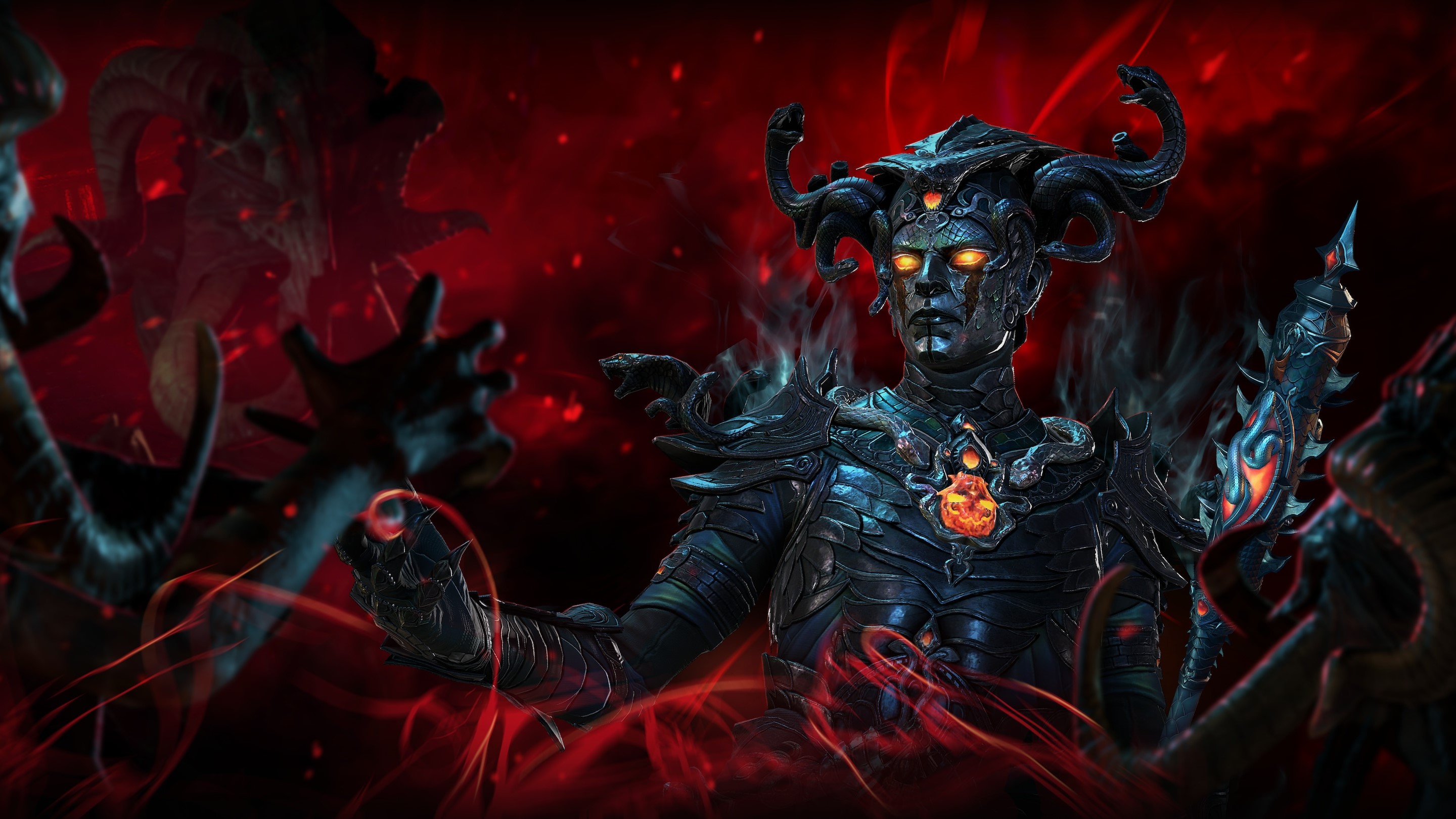AMD unveils new Radeon RX 7900 XTX GPU with RDNA 3 to take on Nvidia RTX 4000
Together we advance_gaming
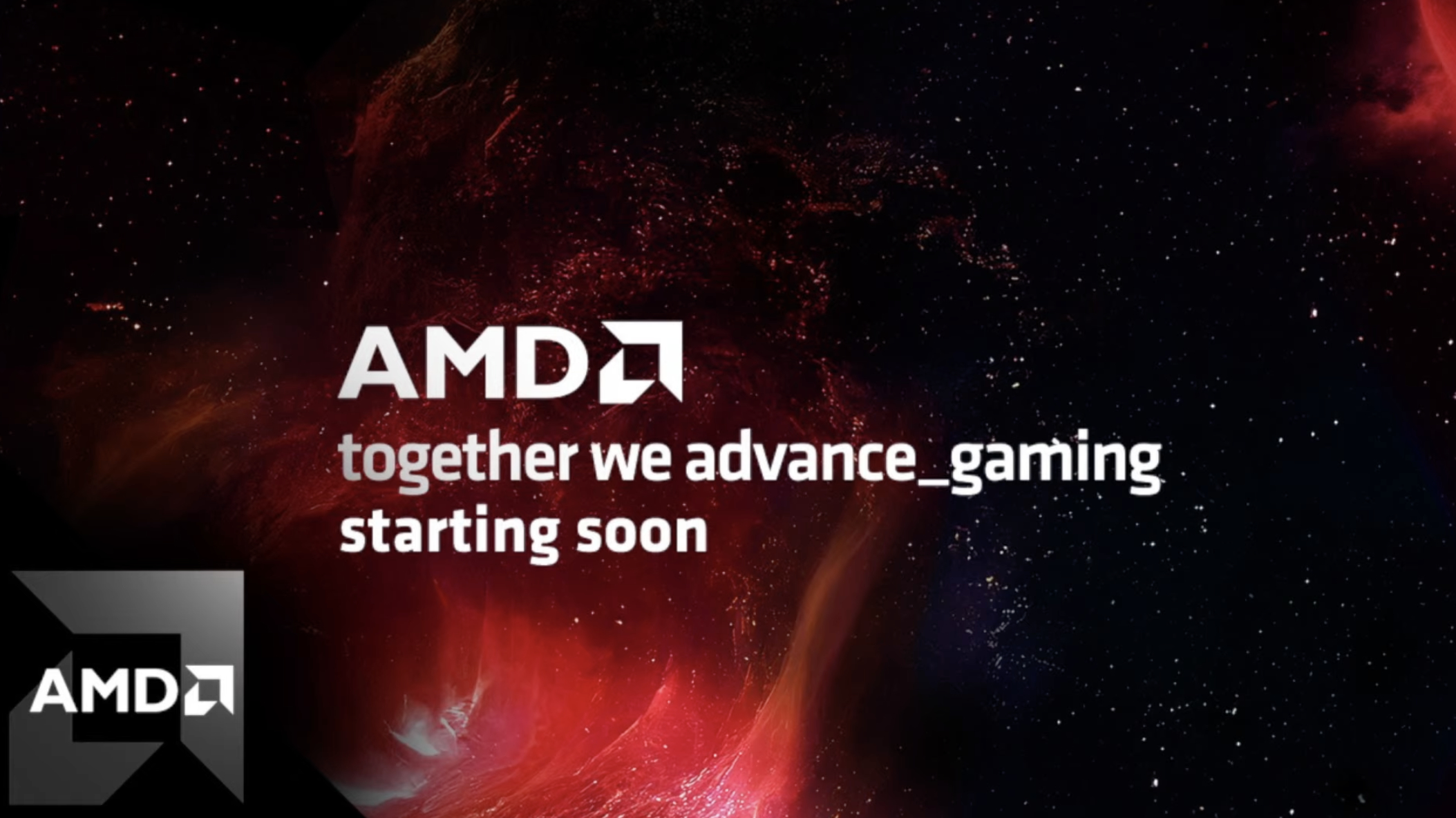
What you need to know
- AMD is moving onto a new RDNA 3 architecture for its new Radeon RX 7000 series of GPUs. With RDNA 3, AMD is bringing its chiplet architecture design to graphics, and these new GPUs use the world's first chiplet-based designs.
- The company is starting out with two premium PC graphics cards for the RX 7000 series. These include the new Radeon RX 7900 XTX and the Radeon RX 7900 XT. The XTX model is the more powerful of the two.
- The RX 7900 XT starts at $899 and will arrive on December 13. The more premium XTX card will start at $999.
- AMD claims better performance with the new unified RDNA 3 compute cores, improved raytracing capabilities, stronger A.I. performance, and more.
- The new RX 7900 series will be the first GPUs to support the new DisplayPort 2.1 standard. Coupled with the RDNA 3 architecture, AMD is claiming that gamers can play 4K and 8K titles with very strong frame rate performance.
AMD took the wraps off of its latest Radeon RX 7000 family of graphics cards at its Together we advance_gaming event in Las Vegas, Nevada. The Radeon RX 7000 series of GPUs will succeed the current Radeon RX 6000 family and rely on AMD's new RDNA 3 graphics cores as the company takes on rival Nvidia's recently unveiled GeForce RTX 4000 series of GPUs. The company's latest flagship RX 7900 XTX and 7900 XT GPUs will be powered by its new RDNA 3 cores.
"At AMD, we're all about high performance and adaptive computing," CEO Lisa Su said during her company's keynote, noting that AMD is in the midst of introducing four new architectures across multiple product lines.
Su said that gaming is in AMD's DNA in unveiling the RDNA 3 architecture.
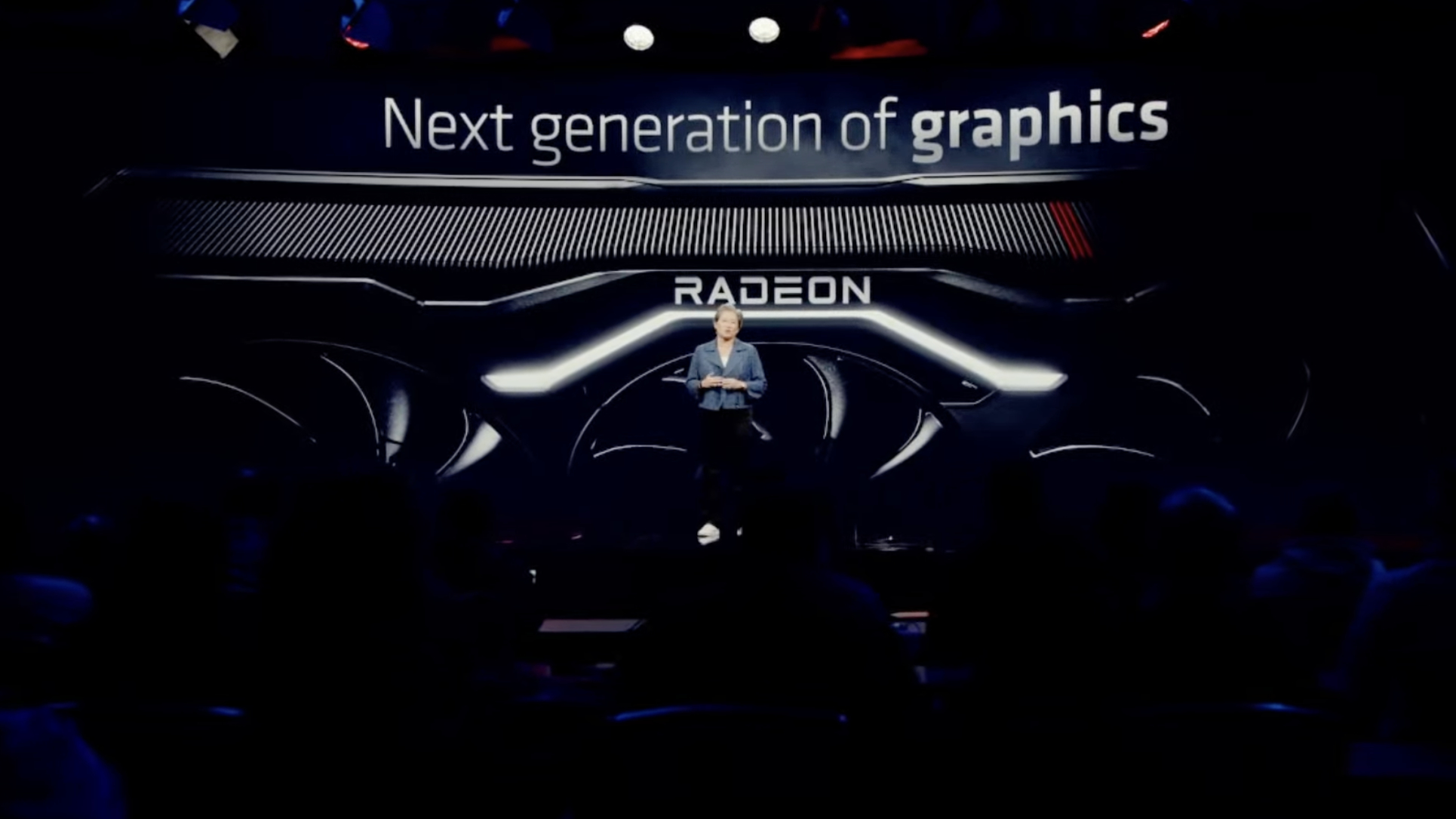
"Our mission is to bring you the best experience possible," Su added. In addition to powering AMD's PC graphics cards, the company's GPU cores are also found on consoles, workstations, and smart automotive consoles.
"Today, it's all about the next generation of graphics," Su said. With RDNA 3, AMD set ambitious goals with power and efficiency. AMD is pushing its performance-per-watt leadership with RDNA 3 to support 4K gaming and beyond. "There's a lot of innovation in RDNA 3 and we're going to tell you all about it today."
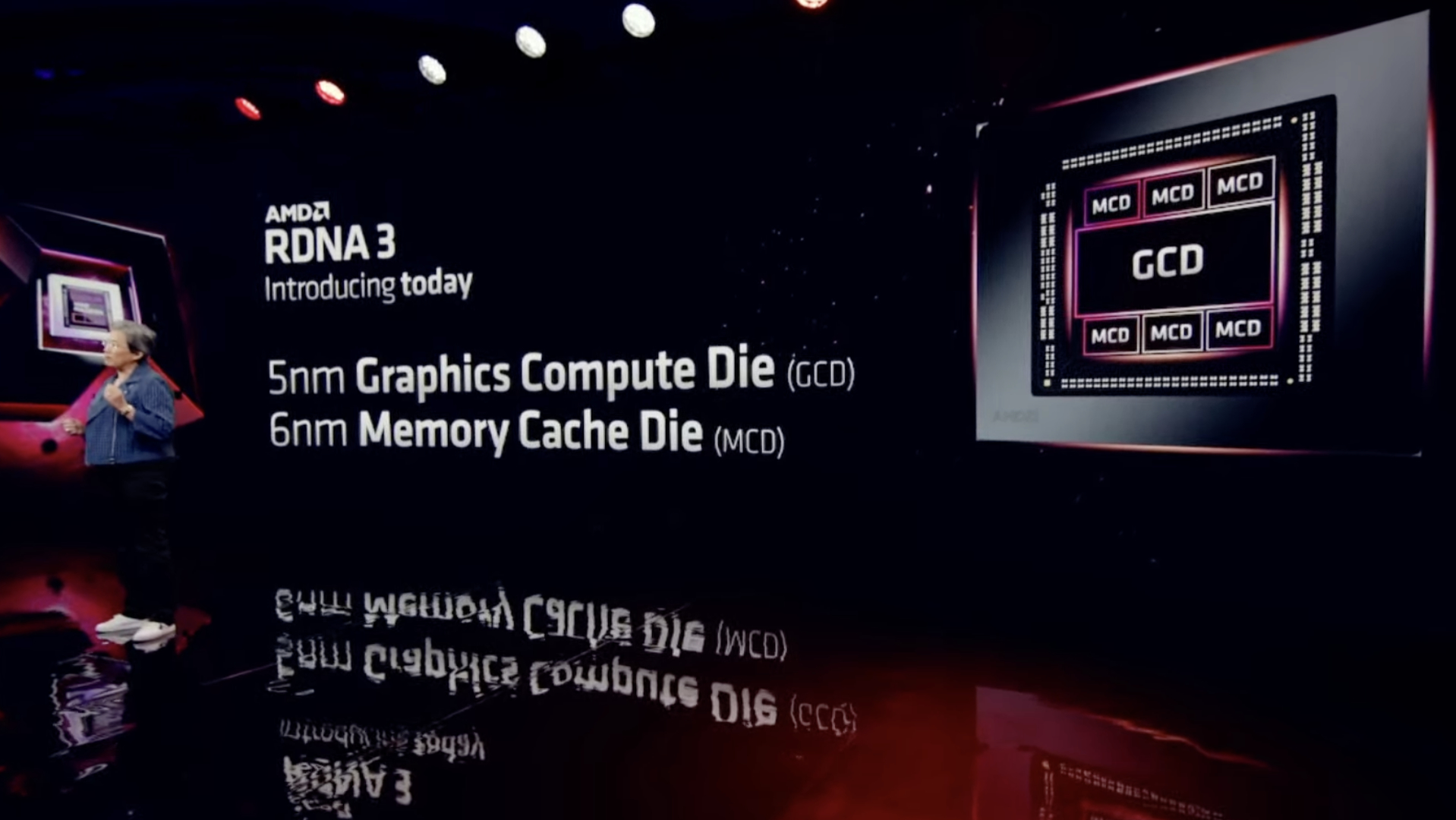
With RDNA 3, AMD is using a modular approach with a chiplet design, mixing and matching the right technology for each function. There's a 5nm graphics compute die and a 6nm memory cache die, which includes the memory subsystem and 96MB of Infinity Cache. "As a result, we have incredible capabilities with 61 teraflops of compute," Su said, noting that the company has the fastest chiplet interconnect.
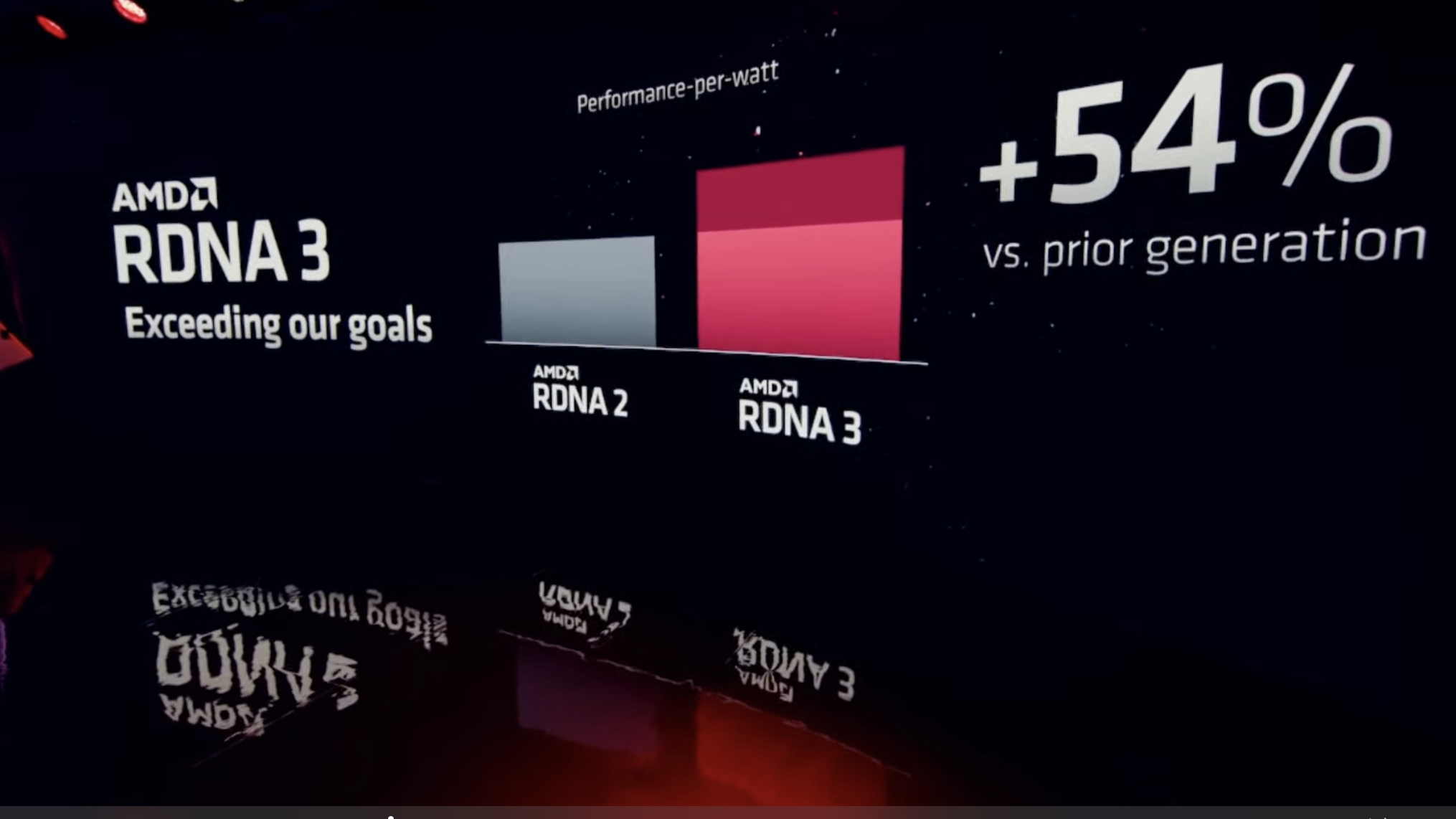
"We have 58 billion transistors in this design," she said.
Get the Windows Central Newsletter
All the latest news, reviews, and guides for Windows and Xbox diehards.
Su claimed that AMD had exceeded its goal with energy efficiency, reaching more than 54% gen-over-gen performance-per-watt with RDNA 3.
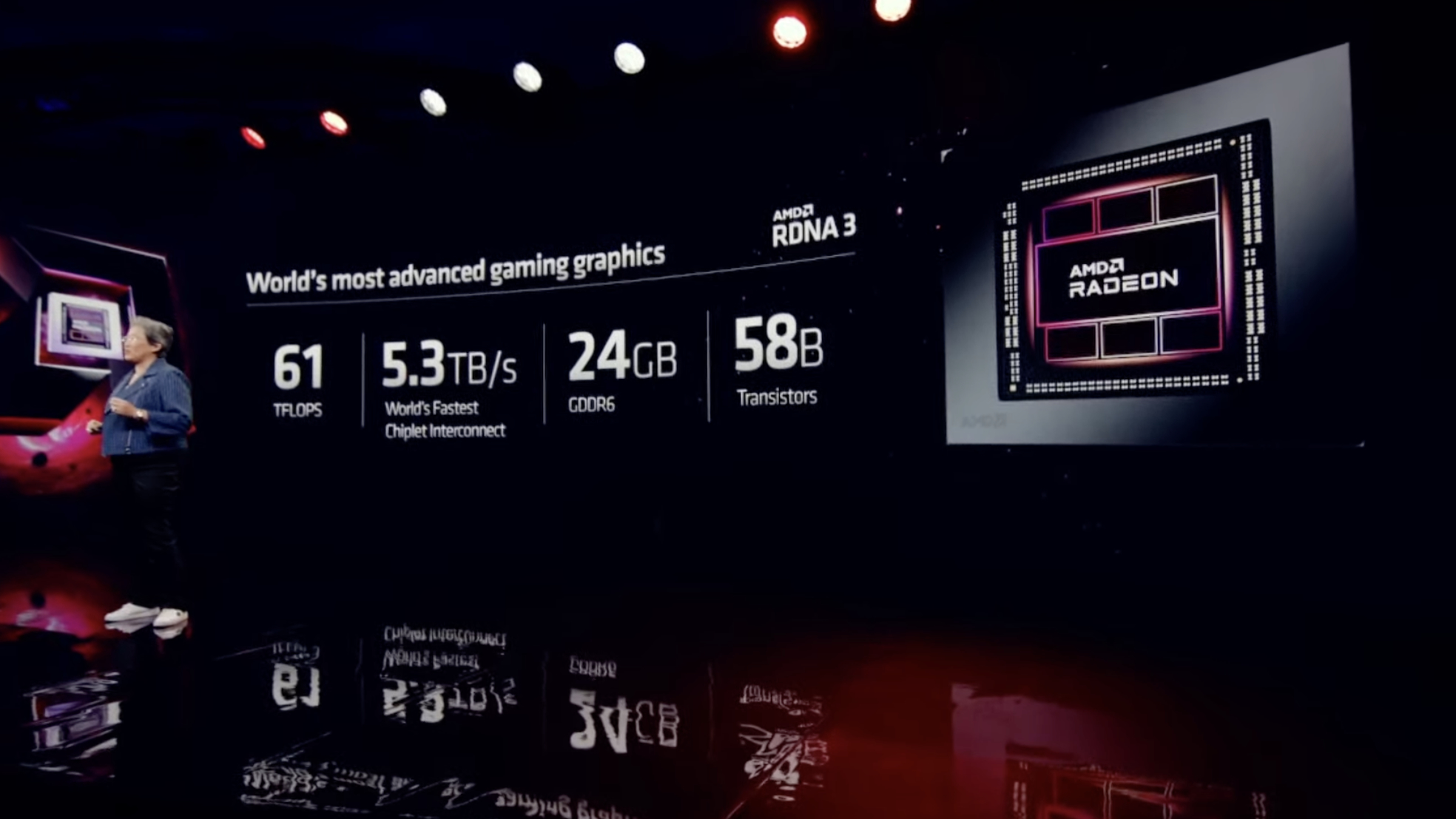
The company unveiled its flagship RX 7900 XTX graphics card with its RDNA 3 architecture at the event along with a high-end Radeon RX 7900 XT GPU.
"With RDNA 3, our vision is to engineer the most advanced 4K and 8K platform, AMD said. "To achieve this vision, we have brought unprecedented innovation."
These innovations include the chiplet design to GPUs, which AMD had honed in on its CPU products. There are two different chiplets that are connected together.
"With RDNA 3, our vision was to engineer the most advanced, 4K and 8K gaming platform for gamers and creators containing the features performance and efficiency to provide the best gaming experience," AMD said. "To achieve this vision, we have brought unprecedented innovation to all aspects of the design."
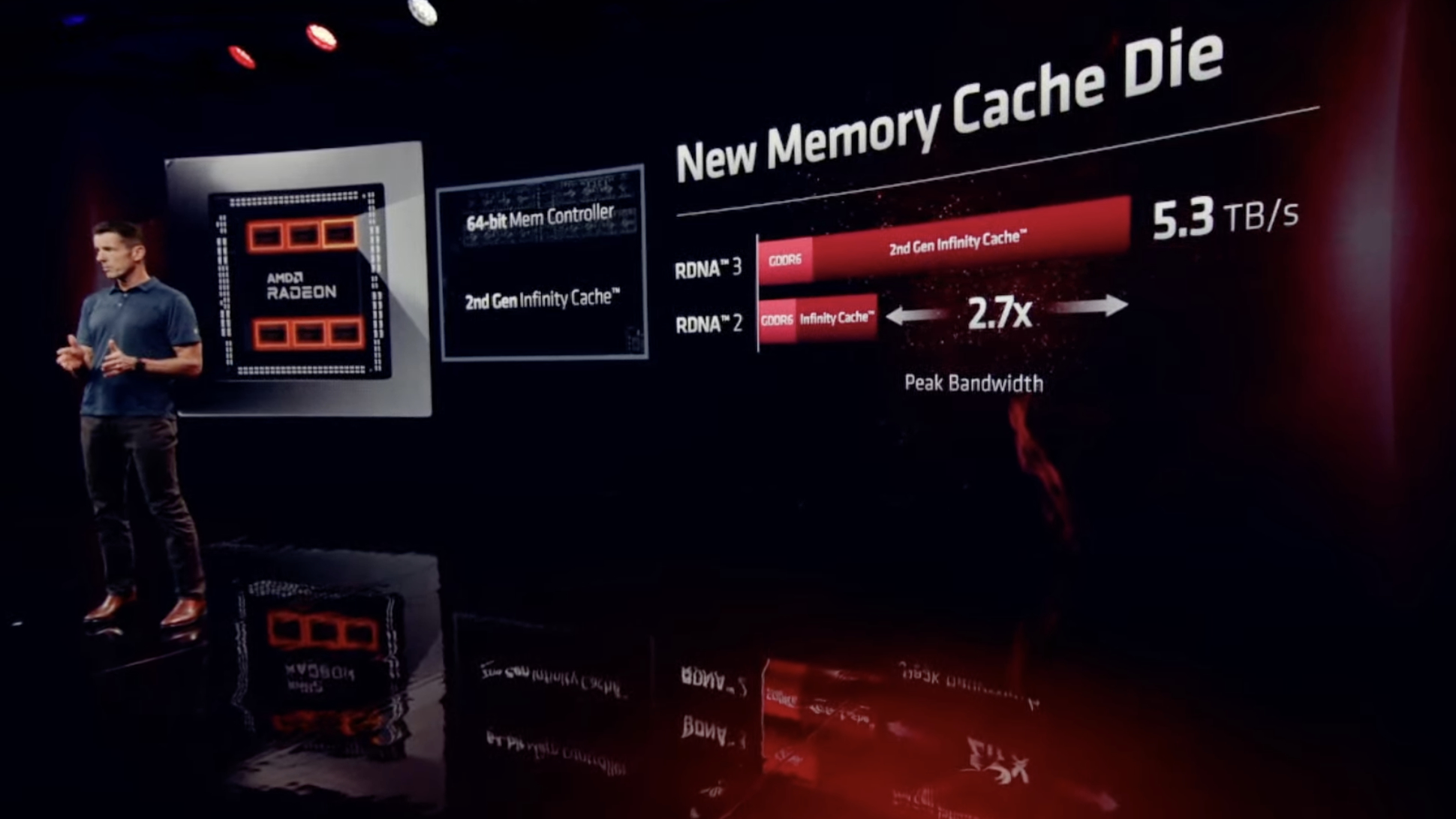
With the chiplet design, AMD claimed that it was able to use the right technology for the right job to maximize performance and boost efficiency.
"So we created two very different chiplets connected with high bandwidth interconnects specific to graphics," AMD said. "With the graphics compute die, we spend that precious five-nanometer silicon where it matters in the core GPU engine, where all the computation occurs to enable great performance and performance per watt."
The graphics chiplet uses the company's area efficient unified architecture that shares resources between rendering AI and ray tracing to make most effective use of each transistor, AMD added. AMD is focusing on high resolution gaming, with solid 4K and 8K gaming performance, with this latest RDNA 3 graphics design.
"The key word here is unified, which means we have a tightly integrated unit, which shares resources to deliver the most power and area efficient performance," the company explained. "We've tuned it to provide the right blend of flexible, highly efficient stream processing, additional A.I. acceleration capabilities, and greatly enhanced raytracing acceleration. All of this is fed by a general purpose register file with 50% more capacity than the RDNA 2 design, which boosts the performance of all the functions. To deliver this well rounded feature set, we've leveraged 5nm to the fullest to pack 54% more transistors in less area, increasing our density by 165%."
On the memory die, AMD used the more mature 6nm technology to implement GDDR6 and its second-generation Infinity Cache design.
The new memory die cache has been increased to 5.3TB/s, and AMD claimed that the tuned Infinity Cache is 2.7x faster than the RDNA 2 design.
"These diminutive but powerful NCDs feature a second-generation infinity cache, each connected to 64 bits of high speed GDDR6 memory, combined with up to a width of 384 bits," the company stated. "We've turned this Infinity Cache to enable better data reuse with less capacity to accomplish several things for us. And this delivers data to the engine at less time and uses less power than going out to DRAM."
On the graphics compute die, it's built using the new RDNA 3 core, which comes with new display engine and dual media engine.
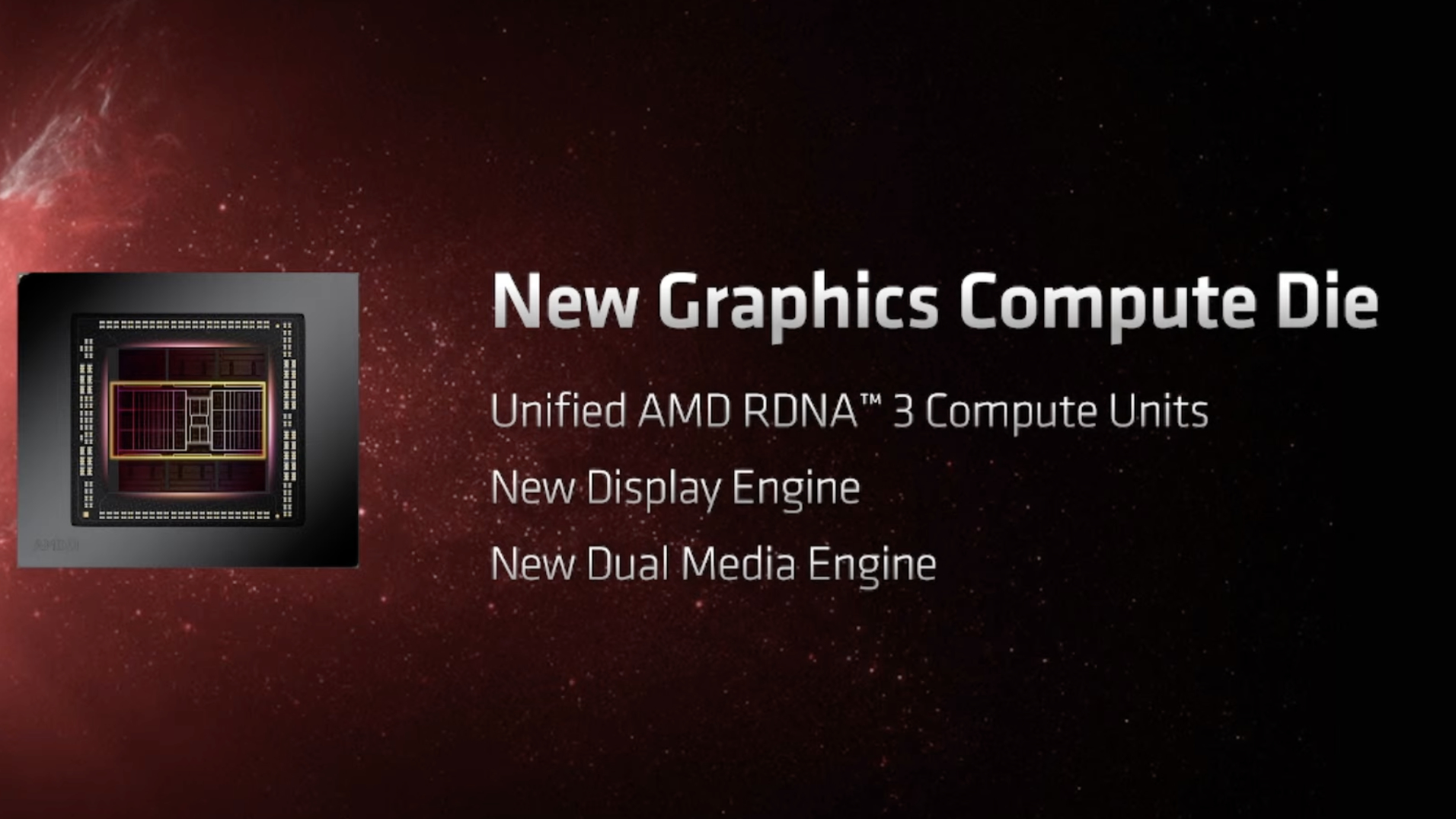
The company claimed that with the RDNA 3 architecture, there's now 165% more transistors per square millimeter on the chip. This leads to improvements like improved A.I. processing and better ray-traying performance. A.I. performance has been improved up to 2.7x, AMD said.
"These improvements provide compelling gains for raytrace gaming content, with up to 50% more performance for computing," AMD said.
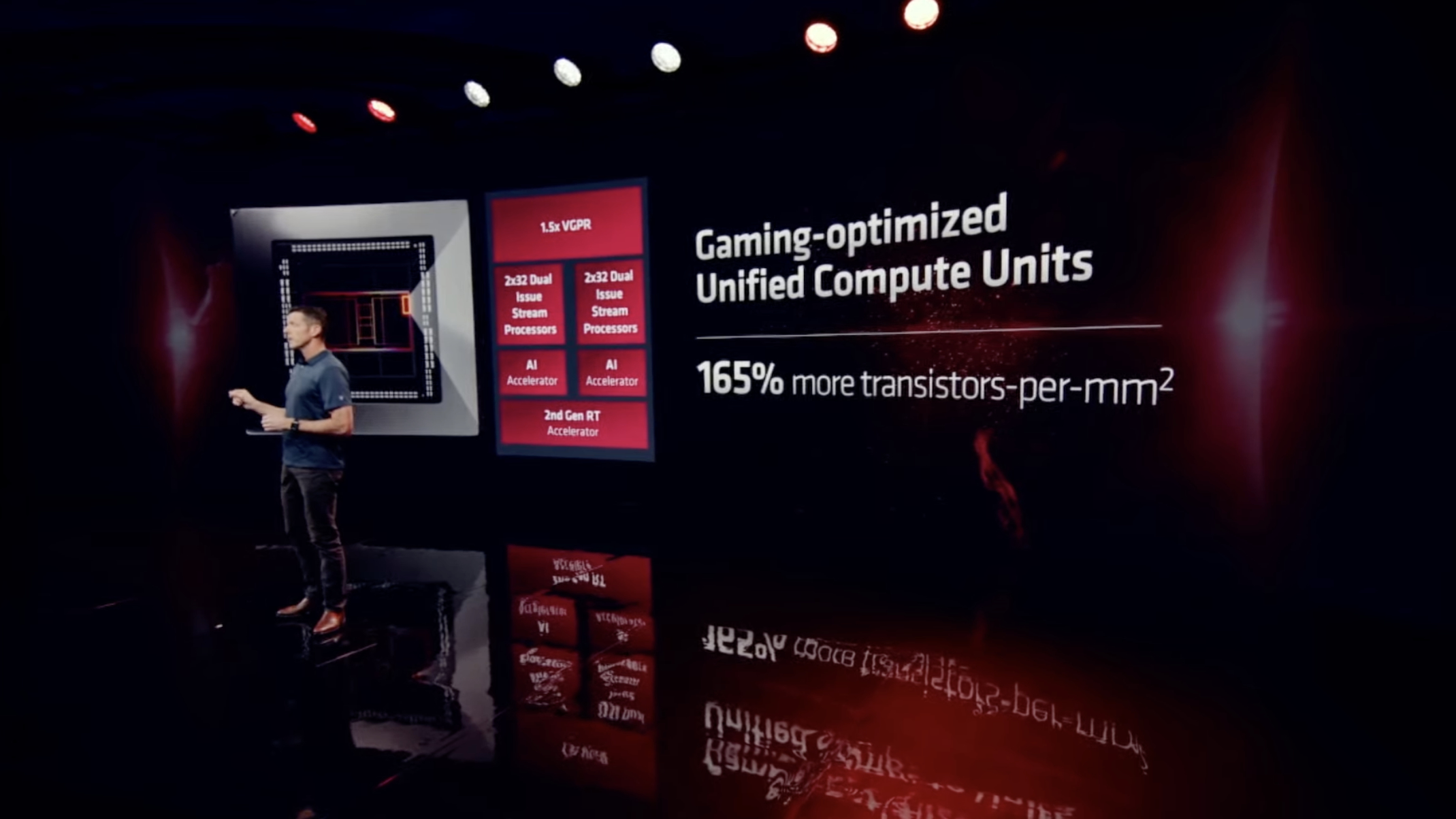
And with dual SIMD, AMD claims that the chipset can now handle two times the instruction issue rate.
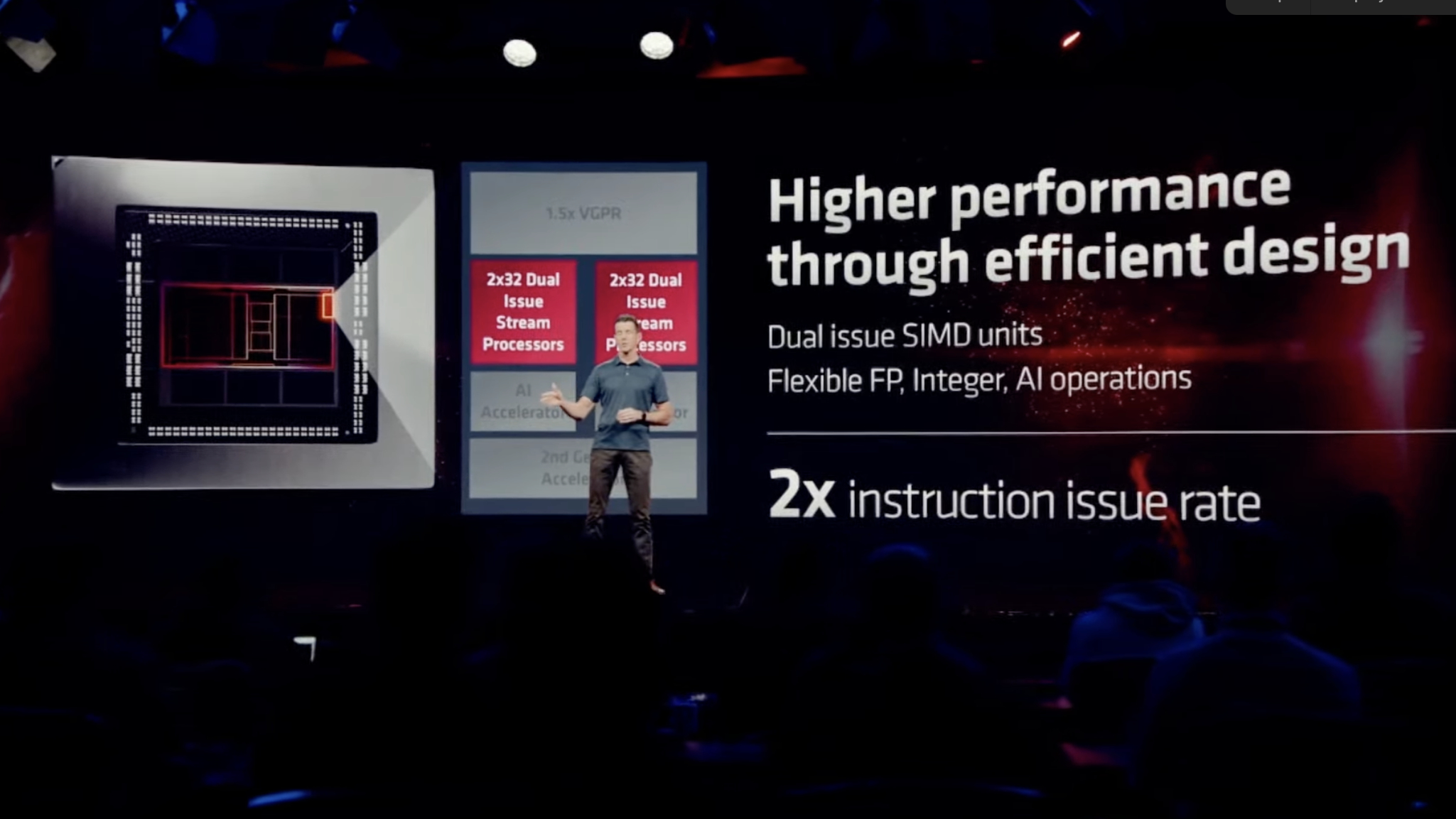
The new Radiance Display Engine supports DisplayPort 2.1, a first for a high performance graphics card, the company said. It supports 8K 165Hz or 4K 480Hz.
The dual media engine supports two media or encode stream. The performance has been improved by 1.8x, reducing the export time by almost one-half.
AMD also made some changes to clock speeds for the front and back end of its shader engine to get more power efficiency.
"So we recognize that we could utilize higher frequencies in a smarter more power efficient way, by using our new to our RDNA 3 decoupled shader engine frequencies to run only the front end at a typical 2.5 gigahertz," AMD explained. "While the shaders operate at a more efficient 2.3 gigahertz, which is still 50% higher than our RDAN 2 launch. With the sort of advanced power management we deliver the maximum frames per second, while also saving up to 25% power. This contributes to a remarkable 54% product level performance. With a higher frequency and the new dual issue our RDNA 3 compute units, we enable a 2.7x leap and raw compute power."
AMD Radeon RX 7900 XTX
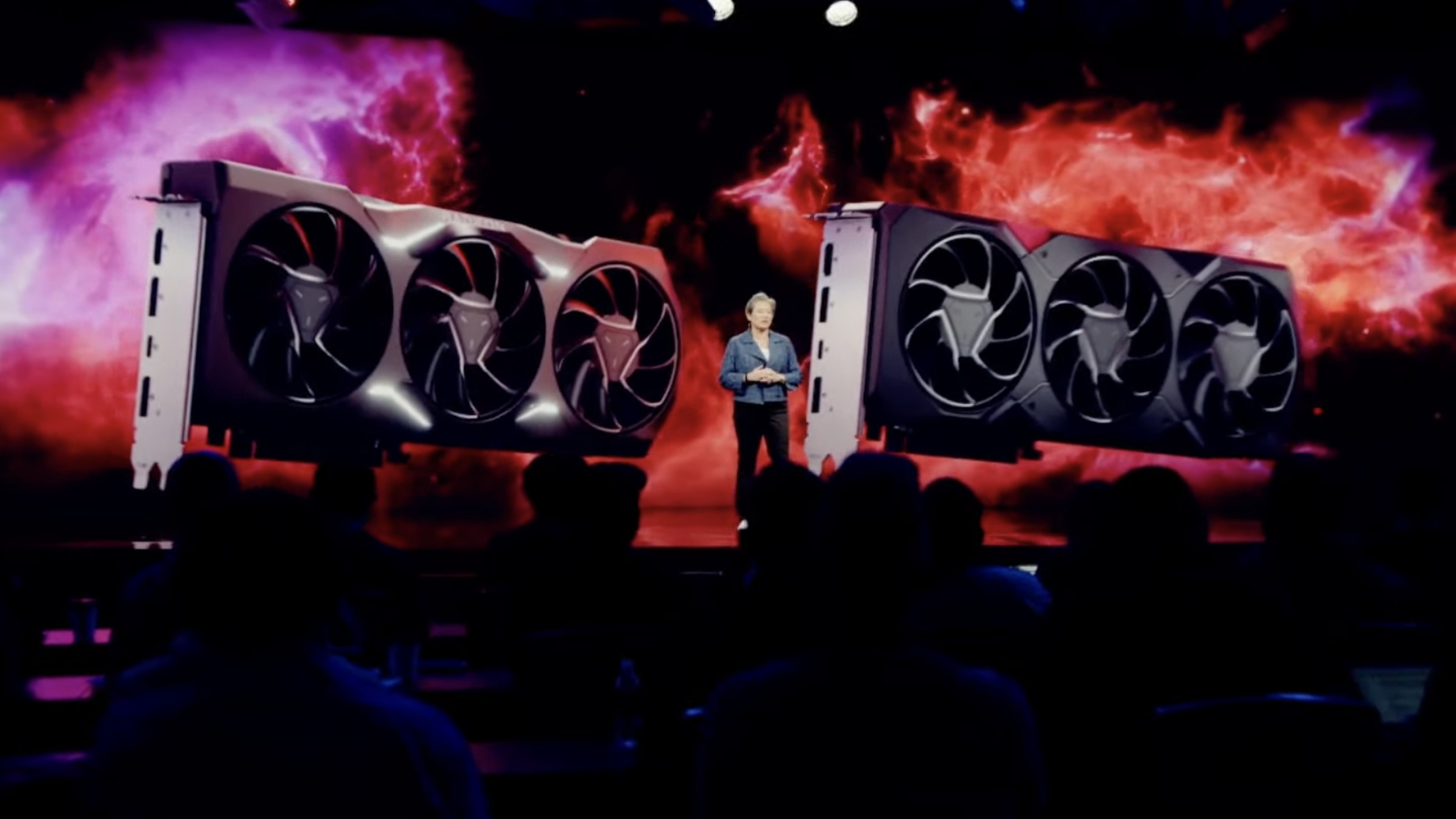
"We've been working on this for three years, hundreds of 1000s, if not millions, of hours in our engineering group," said AMD SVP Scott Herkelman of the Radeon RX 7900 XTX's design.
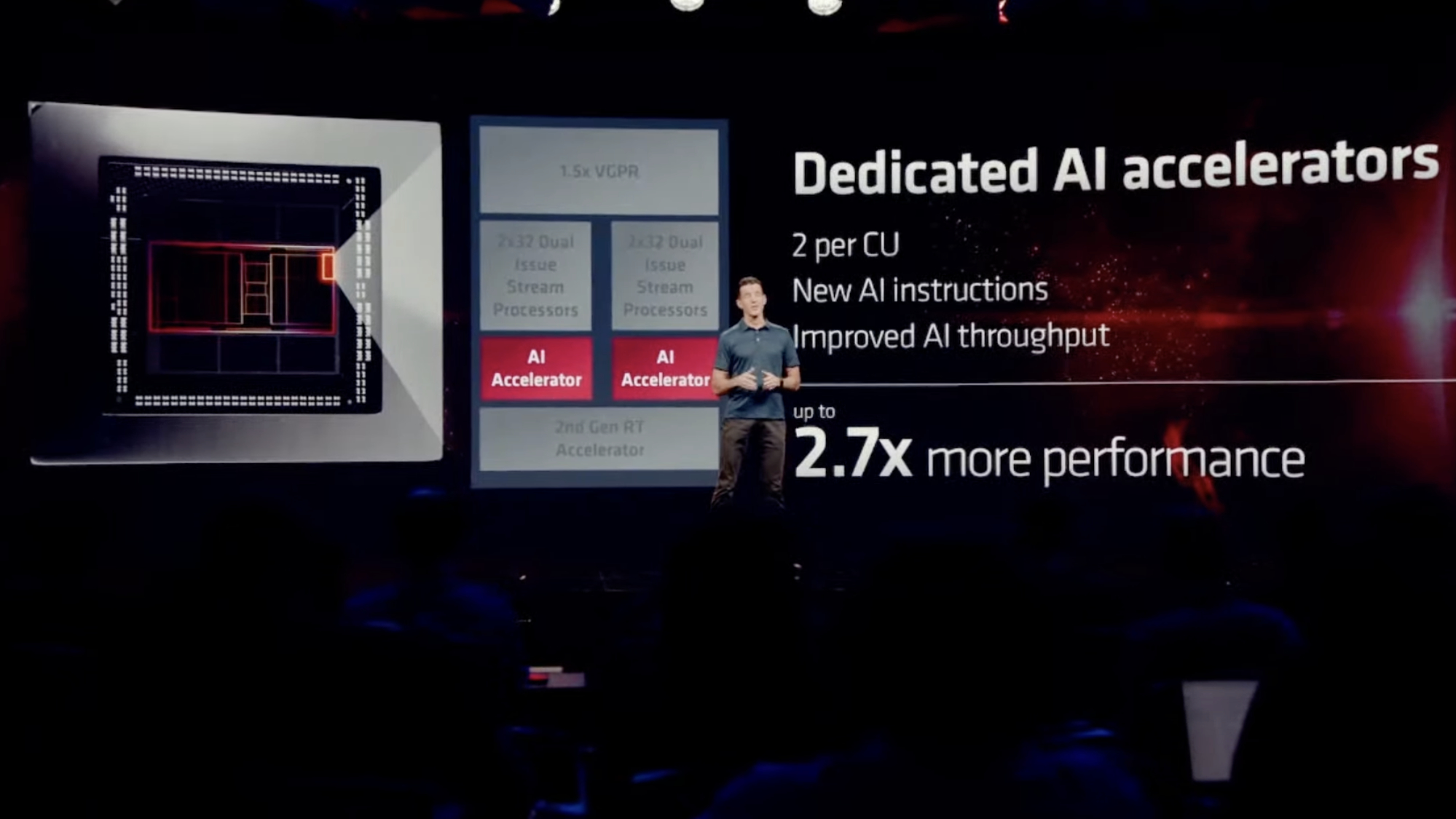
The RX 7900 XTX is built around 4K gaming and beyond, he said, noting that the new flagship GPU is up to 1.7x faster at 4K gaming than its predecessor.
"In pure rendering the RX 7900 XTX is up to 1.7 times faster than our previous generation flagships," Herkelman revealed of the GPU's performance, citing the company's own testing and benchmarks. "And in raytracing, we are seeing up to 1.6 times more performance at native 4k."

The RX 7900 XTX comes with 96 unified RDNA 3 core compute units and is clocked at 2.3GHz. It comes with 24GB of GDDR6 memory. It's future-ready, AMD said. The card uses 355W of total board power.
With A.I. performance, AMD stated that there are now two A.I. accelerators per comput unit, and coupled with the hardware changes, performance has now been boosted to 2.7x over the prior generation.
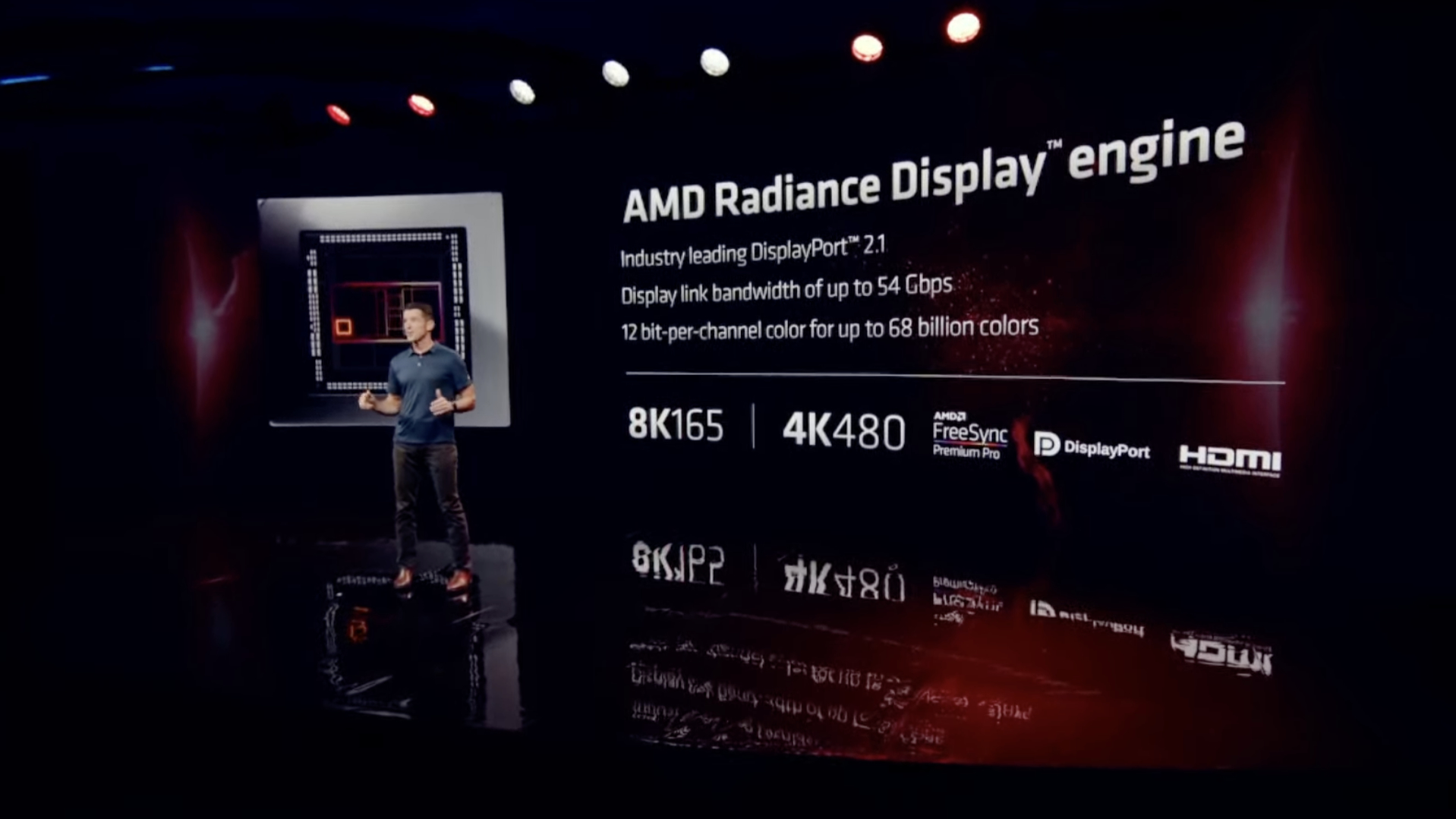
Additionally, the new RDNA 3 platform also supports DisplayPort 2.1.
"And it has the latest DisplayPort 2.1 technology for up to 4K, 180 frames per second or 8K, 165 frames per second gaming capabilities," he added. "This display port enables 480 hertz refresh rates at 4K resolution and up to 165 at 8K. And the 12 color bits per channel enables an incredible 60 billion colors for amazingly realistic images and graphics."
Radeon RX 7900 XT
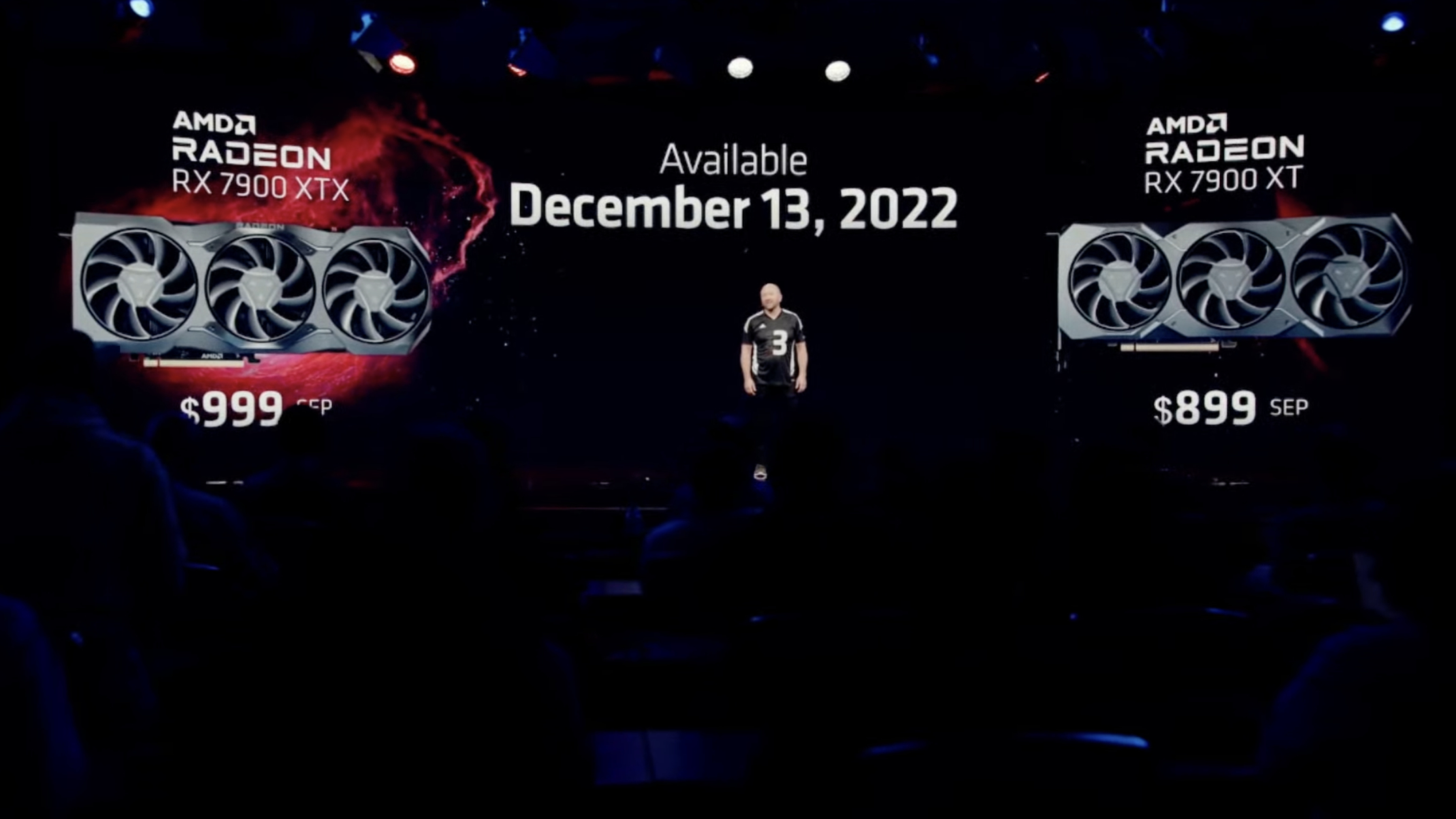
In addition to unveiling the flagship Radeon RX 7900 XTX, AMD also launched its high-end Radeon RX 7900 XT GPU. The scaled-down 7900 XT comes with 84 unified compute units, also based on the RDNA 3 platform, and is clocked at 2GHz. It comes with 20GB of GDDR6 memory and supports the same AV1 encoding and decoding, DisplayPort 2.1 standard, and energy efficiency leadership from its more premium sibling.
Taking a jab at rival Nvidia's massive RTX 4090 card, Herkelman stated that the new RX 7900 series will fit into existing PC cases and is an easy upgrade for many gamers.
"There is no need to rebuild your desktop, no need to upgrade your case and there's no need for a new power adapter," he quipped. "We made it as easy as pulling out your old card and putting in a new GPU."
AMD stated that while the recently launched GPUs from rival Nvidia only support DisplayPort 1.4, the new Radeon RX 7900 series uses the new DisplayPort 2.1 standard.
"If you are paying that much money for a brand new gaming card, you should demand a GPU that will allow you to game into the future and only the 7900 series can you do that," Herkelman said, adding another jab at Nvidia's pricey RTX 4000 series launch.
AMD revealed that new DisplayPort 2.1 monitors will be coming from brands such as Dell, Samsung, Asus, and Acer starting in early 2023. These monitors will be announced at CES 2023 in January.
"The new unified our RDNA 3 compute units have twice the instructions per clock, enabling them to fully utilize our data paths and provide incredibly high performance for rendering, Ray tracing and AI applications in the most power and area efficient way," AMD said.
The RX 7900 XTX is priced at $999 starting December 13, 2022, while the RX 7900 XT will be priced at $899.
AMD Advantage for Desktop
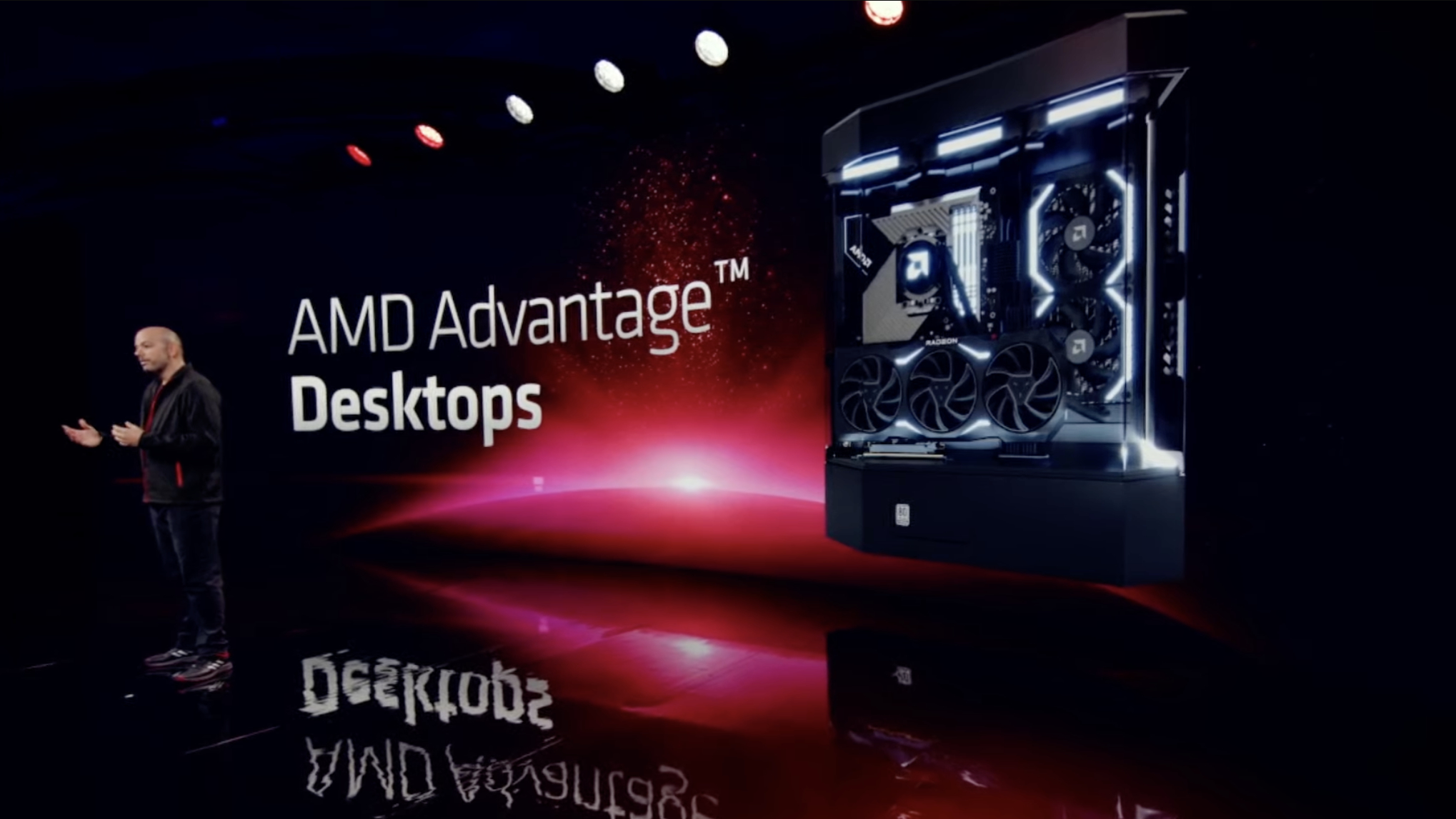
For gamers who want to adopt AMD's latest silicon and may not have time or experience to build their own PCs, the company is now bringing its AMD Advantage program to desktops.
"We've applied the great AMD Advantage design framework that we applied to laptops originally, and we're bringing that to desktops now," AMD said. "We partnered with several leading system integrators to bring you these turnkey solutions. So whether you're gaming, you're streaming or creating, Advantage desktops have been designed and developed with our partners to be the best desktops you'll find in the market."
These desktop builds come with a carefully curated selection of PC components designed to deliver consistent, reliable performance for gamers. The company claimed that it is working with its partners to tune these systems, so that in addition to getting the right components to work, it's also delivering memory, cooling, and other solutions that work seamlessly together for maximum performance.
Pushing resolutions and frame rates
AMD took the opportunity to showcase its software enhancements and solutions that take advantage of the new performance of RX 7900 series as well as support for DisplayPort 2.1, including Fidelity FX Super Resolution and Smart Access Memory.
"Combined with our new unified RDMA 3 compute units, the Radeon RX 7900 series delivers the next generation of high refresh rates," the company said.
Fidelity Super Resolution, or FSR, upscaling is now available in 216 games, with AMD noting that the industry is quickly adopting the technology due to its open source nature.
"Our latest update FSR 2.2 reduces super resolution temporal ghosting, not only the artifacts on fast moving objects, and it'll also be available in Forza Horizon 5 soon," he added.
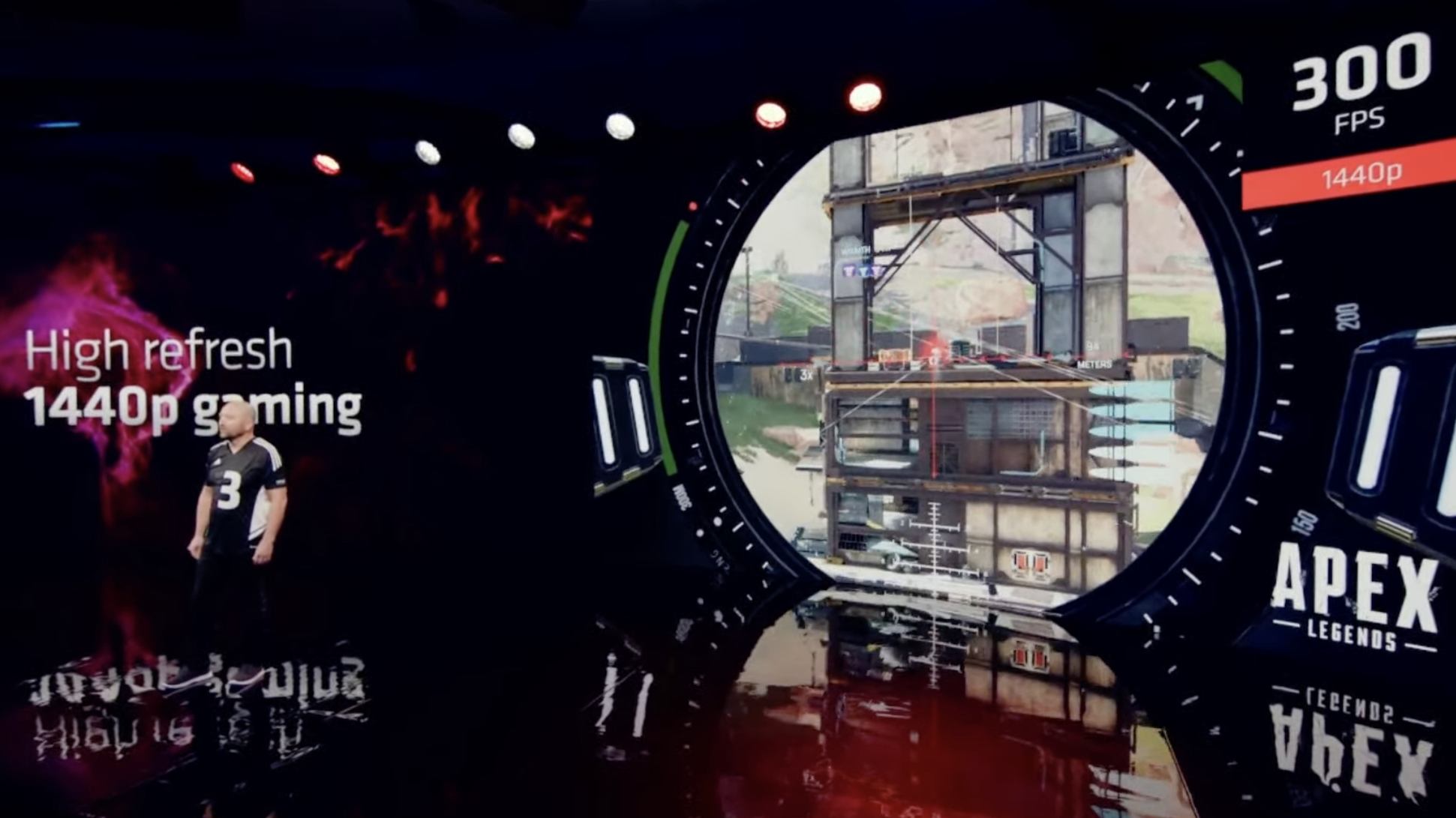
Highlighting the performance of RX 7900 XT for gamers playing at 1440p resolution, Herkelman noted that frame rates can go in excess of 800 FPS!
"With the 7900 XTX and Apex legends, you will be able to reach the game's hard framerate cap of 300 frames per second," he said. "And in other popular titles, the RX 7900 XTX can push your games to its limits."
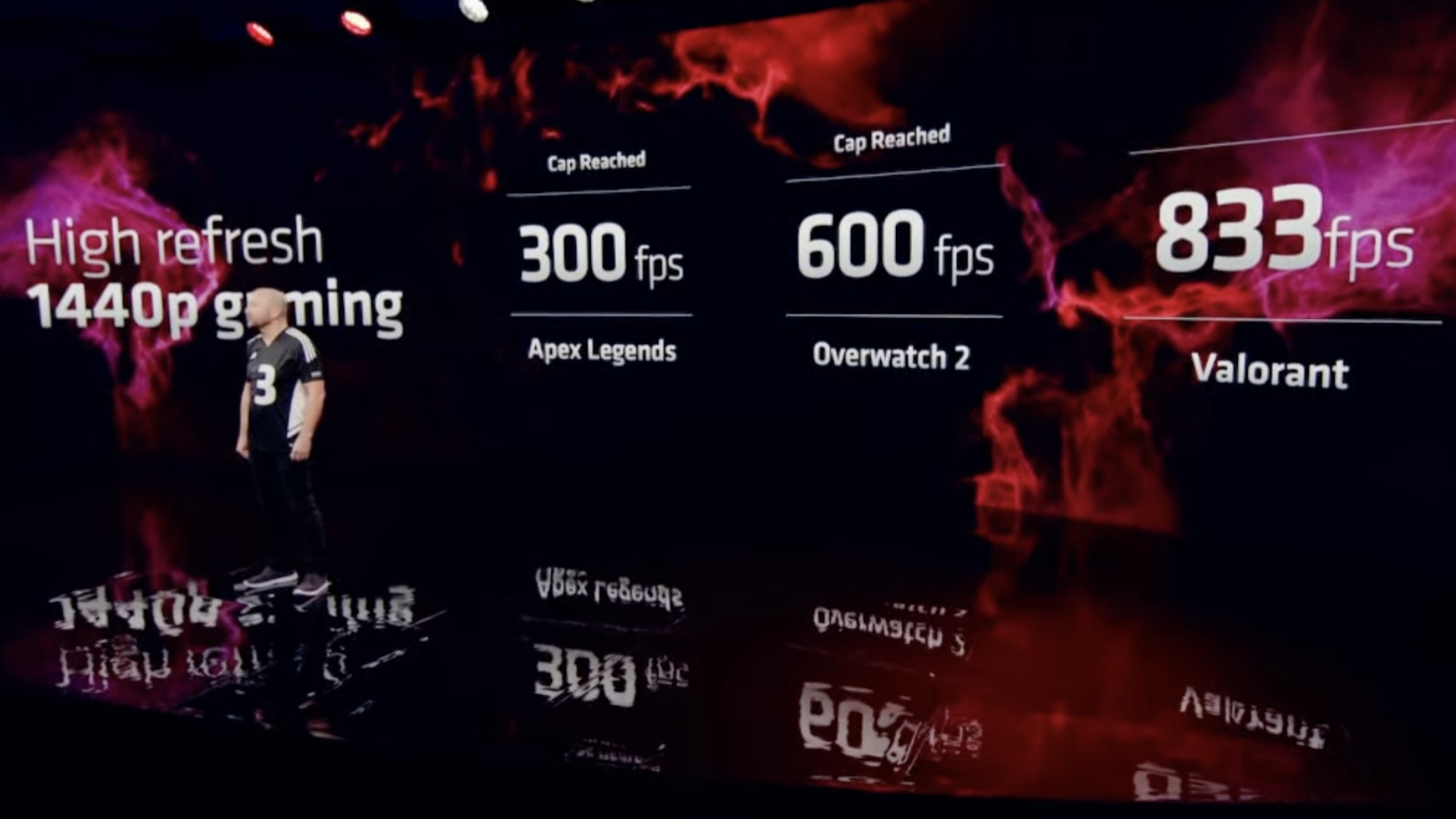
At 4K resolution, titles like Volorant peaked above 700 FPS.
"Now at 4K, the RX 7900 XTX is the card to get," he added. "By turning on max settings in triple A games and using FSR upscaling, you can hit triple-digit performance. It even makes playing competitive Esports titles at 4K a real possibility."
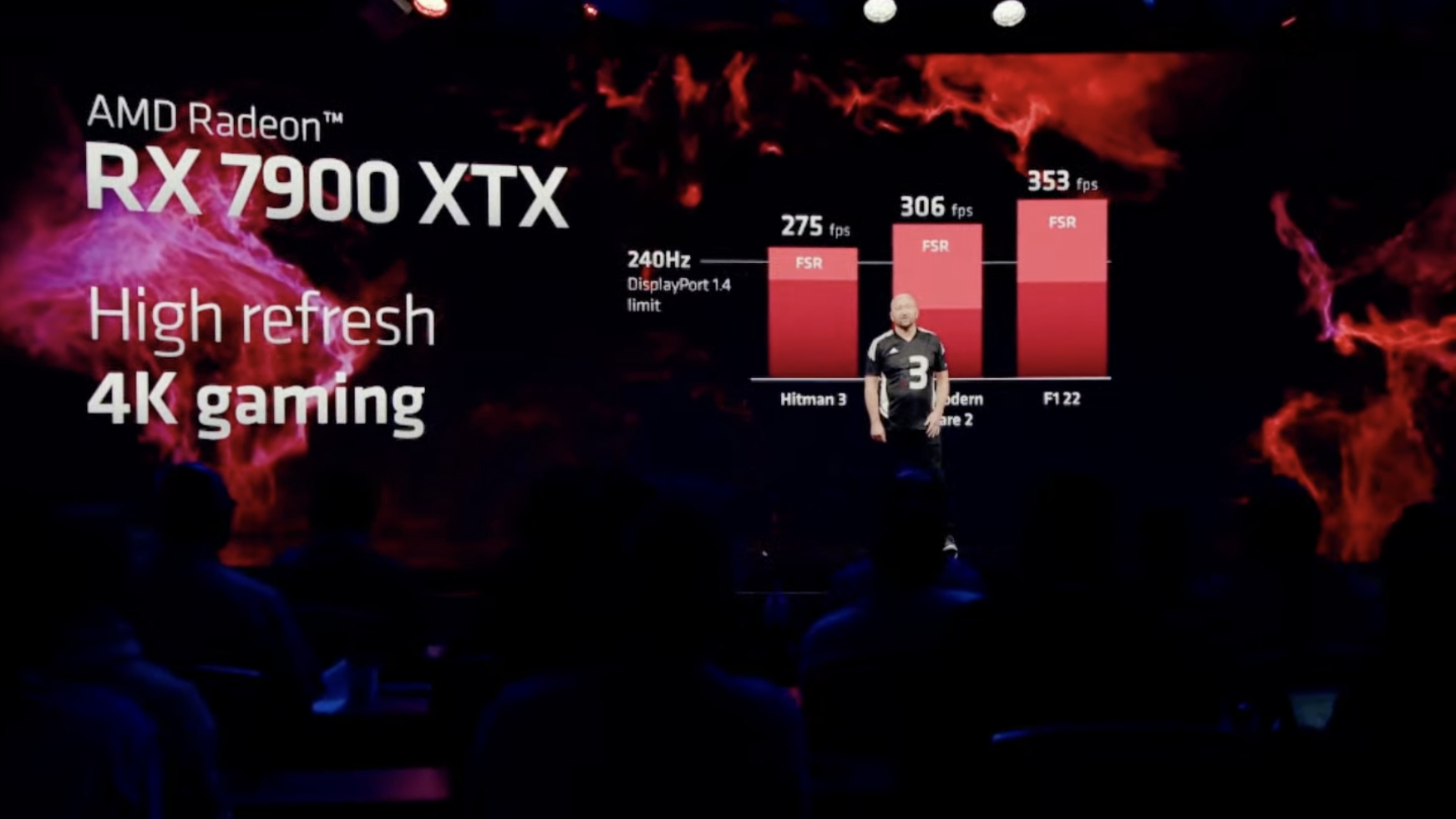
Beyond 4K, AMD showed you can get above 60 FPS at 8K.
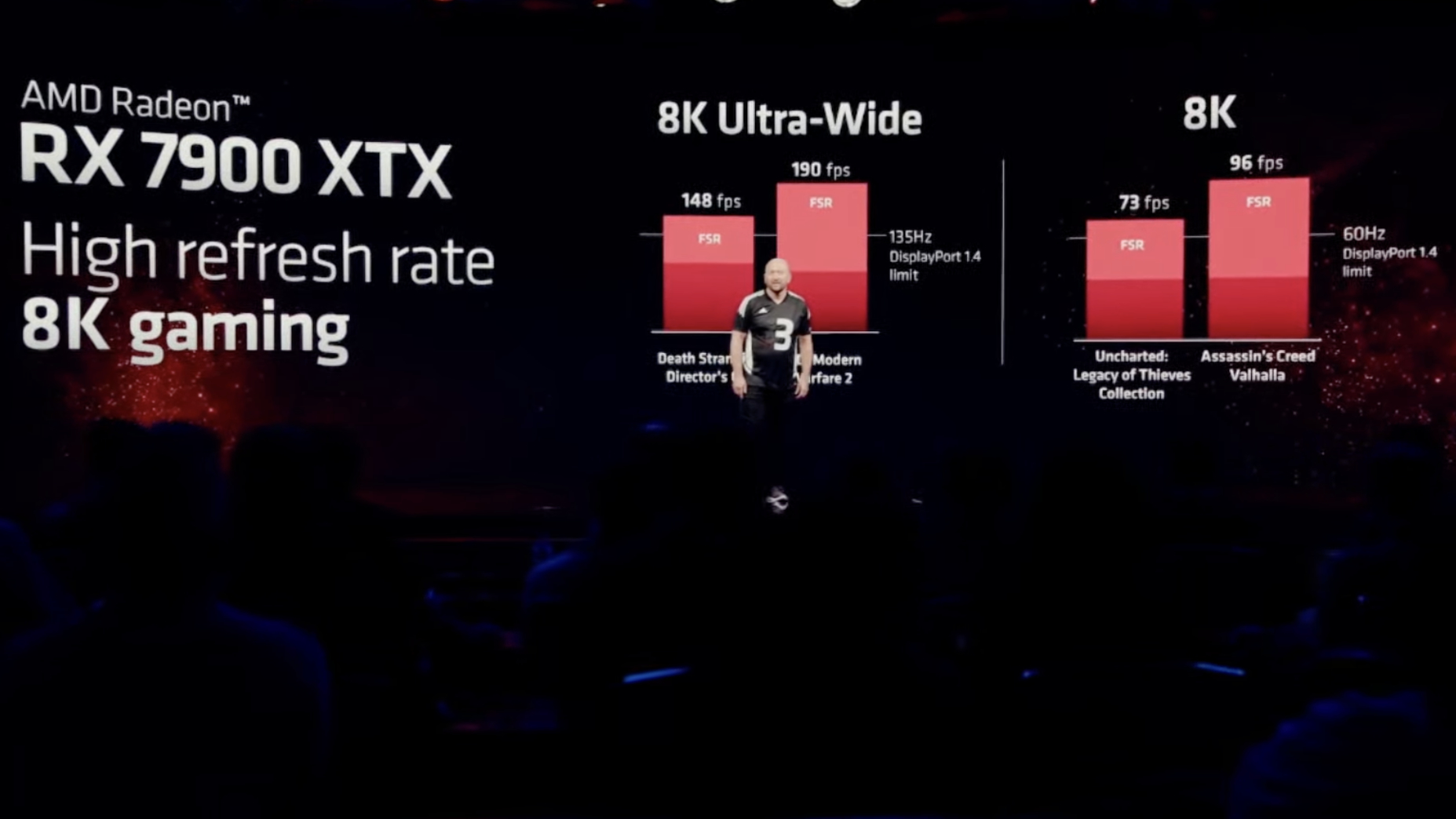
"Assassin's Creed Valhalla with FSR paired with the 7900 XTX, you will be able to get 96 frames per second at a crisp, 8k resolution," he said. "It's truly incredible to see and experience."
The GPU can support 8K ultrawide resolutions as well as 8K 60Hz displays.
Raytracing on the RX 7900 series
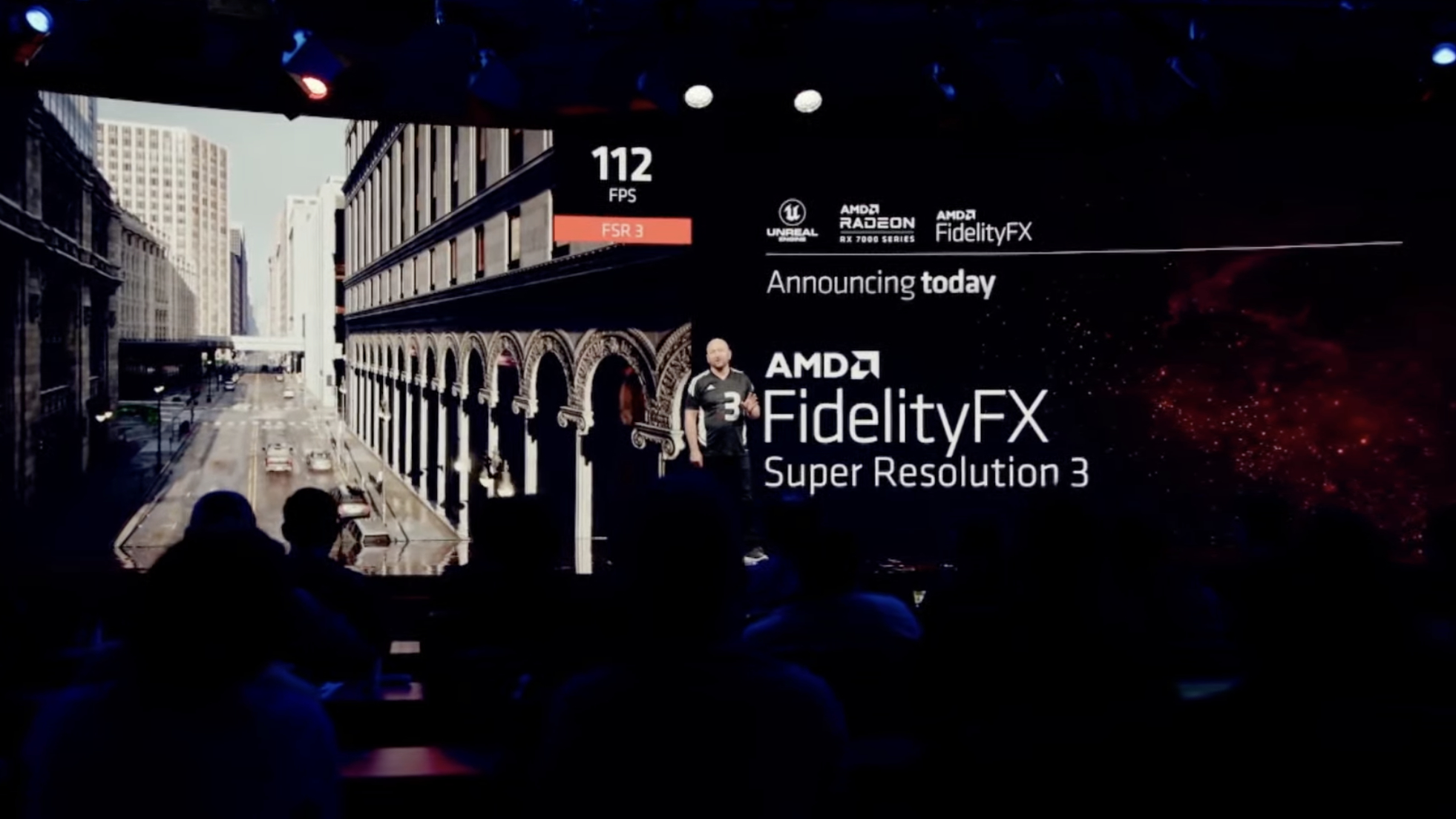
In addition to better gaming performance, AMD also announced that its new cards will deliver better raytracing performance. The company previewed that DirectX Raytracing is coming to Halo Infinity.
"Halo infinite will now support raytrace shadows across arena and big team battle modes, and players with AMD hardware will notice improved lighting, sharper shadows, and increased performance on RX 7000 series platforms with raytracing acceleration," AMD said, noting that DXR will come in season 3.
And with RDNA 3, AMD noted that real-time raytracing has also improved significantly.
"And with the RNA 3 architecture, real-time raytracing performance has greatly improved generation over generation, and Dying Light 2 with raytracing features turned to the max, RX 7900 XTX delivered performance above 60 frames per second. with episodic 4K," AMD said.
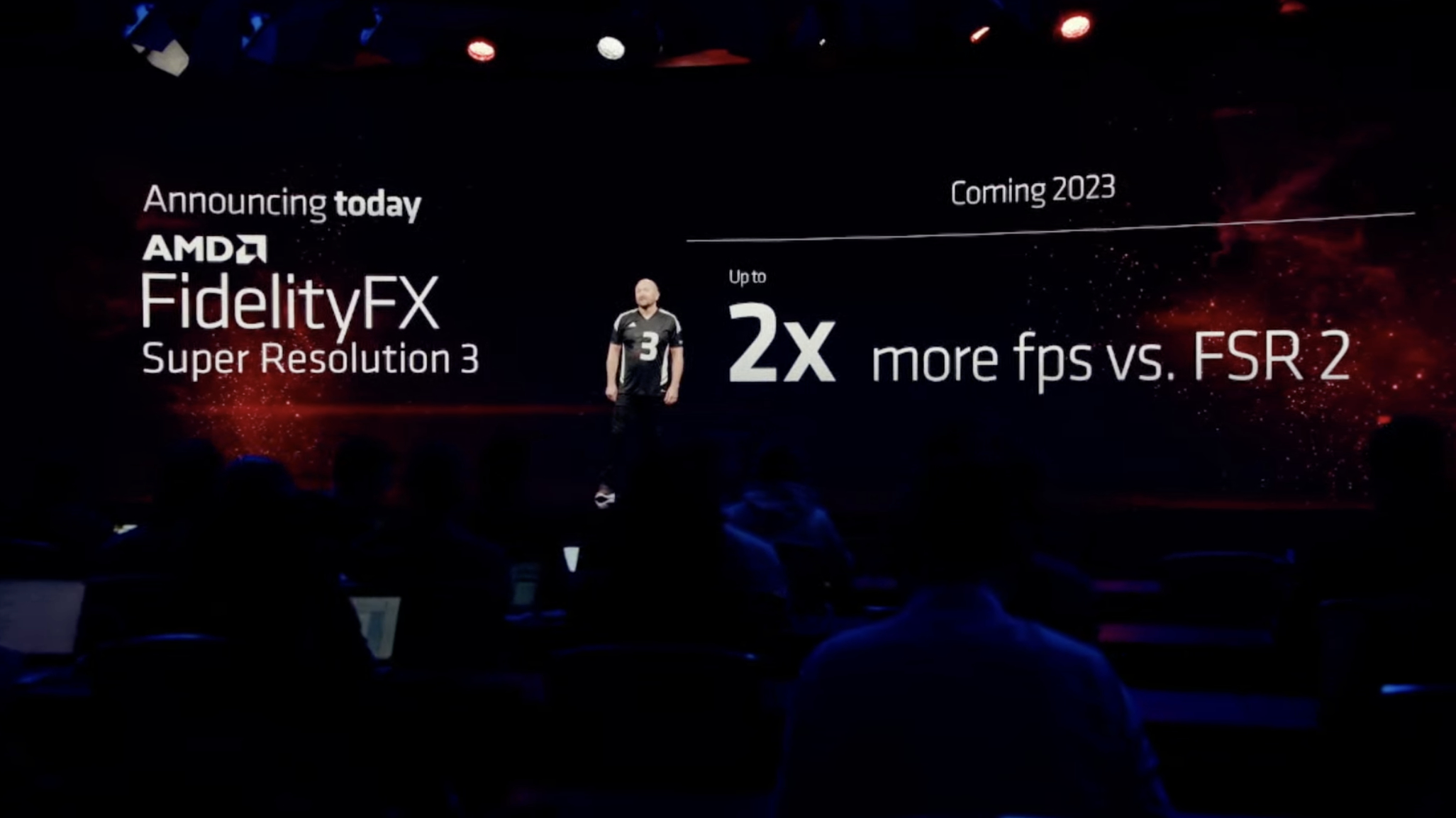
The company also previewed its next-generation Fidelity Super Resolution 3, which delivers even more frames per second in games. With FSR 3, you can get 2x the framerate of FSR 2, AMD said.
"Episode Three will provide up to a two times increase in frames per second at 4K resolution over FSR 2 a significant boost across your supported games and will be coming to PC gamers in 2023," Herkelman said.
AMD also showcased its next generation of its Adenaline software with a new HYPR RX mode.
"With HYPR RX we've redeveloped these performance boosting technologies to all work together at the same time, compounding their benefits and giving you a one click experience to improve framerate and latency," AMD said. The company said that improvements can be as much as 85% with just one-third the latency with HYPR RX mode. The new mode is coming out early next year.
Additionally, for streamers, AMD also made improvements to its OBS software. With support for the AV1 codec, AMD said that it is not only improving resolution, but its Xilinx A.I. engine uses adaptive machine learning to improve the readability of small texts and menus.
AMD also introduced a new Smart Access Video feature for creators and video editors. In order to gain Smart Access Video benefit, you'll need to be fully invested in AMD's ecosystem with both Radeon and Ryzen silicon, and the feature distributes the encoding and decoding across both the CPU and GPU to speed up 4K and 8K editing.
"And when it comes to batch transcoding, Smart Access video reduces parallel transcoding time by nearly one-third," AMD said. "Smart Access video will be available across applications like OBS, Premiere Pro, FFmpeg, and more starting in December."
Chuong's passion for gadgets began with the humble PDA. Since then, he has covered a range of consumer and enterprise devices, raning from smartphones to tablets, laptops to desktops and everything in between for publications like Pocketnow, Digital Trends, Wareable, Paste Magazine, and TechRadar in the past before joining the awesome team at Windows Central. Based in the San Francisco Bay Area, when not working, he likes exploring the diverse and eclectic food scene, taking short jaunts to wine country, soaking in the sun along California's coast, consuming news, and finding new hiking trails.

